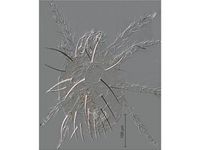Panonychus ulmi
| Literature database |
|---|
| 187 articles sorted by: |
| • year (descending) |
| • research topics |
| • countries/regions |
| • host plants |
| • list of natural enemies |

Author(s): CSIRO
Source: Wikimedia Commons
Panonychus ulmi (Koch, 1836) - (European red mite)
The spider mite is widespread in temperate and subtropical regions and can cause serious losses on fruit trees and in vineyards. The mites feed on the lower leaf epidermis. The attacked leaves stop developing, turn pale and have a bronze colour. They may drop prematurely and the damage results in decreased fruit size and in reduced fruit setting in the following year. On grapevines, quality and quantity of the harvest is affected.
The development time from egg through the larval, protonymph, deutonymph stages to the adult stage lasts 3-4 weeks. There are usually 6 or 7 generations per year. The mite overwinters in the egg stage (so called winter eggs). Outbreaks are typically initiated when the application of pesticides (like pyrethroids) eliminates beneficial predatory mites.
| Vernacular names | |
|---|---|
| • Deutsch: | Obstbaumspinnmilbe Rote Spinne Rote Obstbaumspinnmilbe Gemeine Obstbaumspinnmilbe |
| • English: | European red mite fruit tree red spider mite |
| • Español: | acaro rojo de los frutales araña de los frutales |
| • Français: | acarien rouge des pomacées tétranyque rouge du pommier |
| • Português: | ácaro-vermelho-europeu |
For control, oil sprays are used. Because of the importance of natural enemies, acaricides need to be used with caution. P. ulmi is also often resistant to acaricides. In Canada, the release of pyrethroid-resistant predatory mites has given promising results.
Females are about 0.5 mm long, red with white legs and whitish spots on the back from which long bristles arise. Males are smaller and yellowish.
Synonyms:
Metatetranychus pilosus
Metatetranychus ulmi
Paratetranychus pilosus
- Other images of Panonychus ulmi (PaDIL - click to enlarge)



